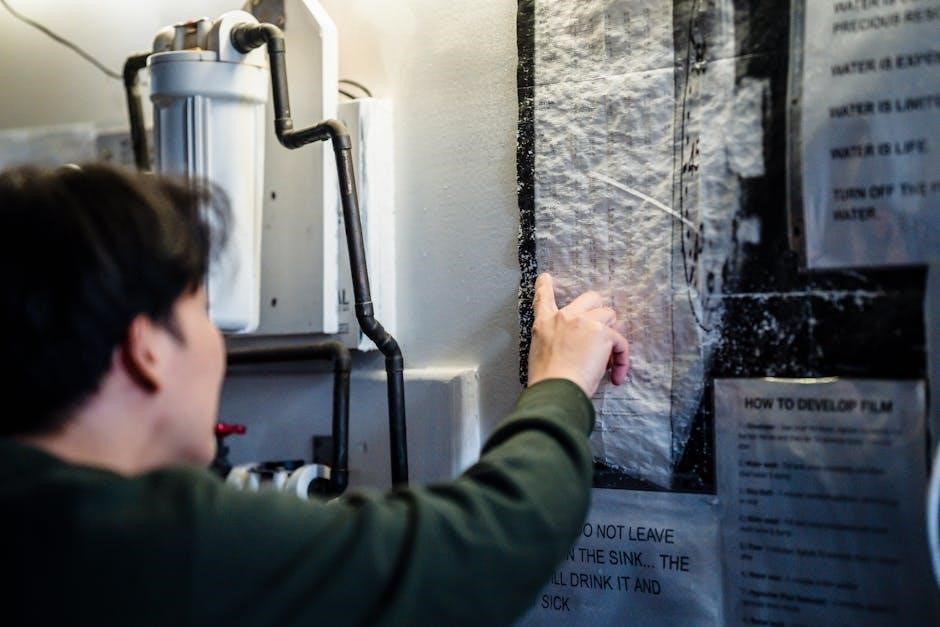Cell division is essential for growth, repair, and reproduction. It involves mitosis, producing identical diploid cells, and meiosis, creating unique haploid cells for sexual reproduction.
1.1. Overview of Cell Division
Cell division is a fundamental biological process essential for growth, repair, and reproduction. It involves the division of a parent cell into daughter cells, ensuring the continuation of life. There are two main types: mitosis and meiosis. Mitosis produces two genetically identical diploid cells, crucial for tissue repair and organism growth. Meiosis, in contrast, generates four unique haploid cells, vital for sexual reproduction. The cell cycle, which includes phases like G1, S, G2, and M, regulates these processes. Understanding cell division is crucial for studying genetics, development, and disease mechanisms. This section provides a foundational overview, setting the stage for deeper exploration of mitosis and meiosis in subsequent chapters.
1.2. Importance of Cell Division in Growth and Reproduction
Cell division is vital for both growth and reproduction. During growth, mitosis allows tissues to expand by producing new cells, enabling organisms to increase in size and repair damaged tissues. In reproduction, meiosis generates gametes with unique genetic combinations, ensuring diversity in offspring. This process is essential for sexual reproduction, as it maintains genetic variation within populations. Without cell division, organisms would lack the ability to develop, heal, or produce offspring. Its role in maintaining life underscores its significance in biology, making it a cornerstone of genetics and developmental studies.

Mitosis
Mitosis is a process of cell division that produces two genetically identical daughter cells. It is crucial for growth, tissue repair, and maintaining genetic continuity in somatic cells.
2.1. Definition and Purpose of Mitosis
Mitosis is a type of cell division that results in two genetically identical daughter cells. It is a continuous process divided into phases: prophase, metaphase, anaphase, and telophase. The primary purpose of mitosis is to replenish cells, enabling growth, tissue repair, and asexual reproduction. It ensures that daughter cells receive the same number and type of chromosomes as the parent cell. Mitosis is essential for development, as it allows organisms to replace dead or damaged cells and maintain tissue integrity. This process occurs in somatic cells and is tightly regulated to ensure genetic stability and accuracy in chromosome distribution.

2.2. Stages of Mitosis
Mitosis is divided into four main stages: prophase, metaphase, anaphase, and telophase; During prophase, chromatin condenses into chromosomes, the nucleolus disappears, and the mitotic spindle forms. In metaphase, chromosomes align at the metaphase plate, attached to spindle fibers. Anaphase involves sister chromatids being pulled to opposite poles, ensuring genetic diversity. Finally, in telophase, nuclear envelopes reform, chromosomes decondense, and the cytoplasm divides. Each stage ensures precise distribution of genetic material, maintaining cellular continuity.
2.3. Differences Between Mitosis and Meiosis
Mitosis and meiosis differ significantly in purpose and outcome. Mitosis results in two genetically identical diploid cells, essential for growth and tissue repair, while meiosis produces four genetically unique haploid cells for sexual reproduction. Mitosis involves one division, whereas meiosis requires two. Crossing over, a process that increases genetic diversity, occurs only in meiosis. Additionally, meiosis reduces the chromosome number by half, while mitosis maintains it. These differences reflect their distinct roles in organismal development and reproduction.

Meiosis
Meiosis is a specialized cell division process that reduces chromosome number by half, creating four unique haploid cells for sexual reproduction, enhancing genetic diversity.
3.1. Definition and Purpose of Meiosis
Meiosis is a specialized type of cell division that occurs in reproductive cells, producing four genetically unique haploid daughter cells. It consists of two successive divisions: meiosis I and meiosis II. The primary purpose of meiosis is to reduce the chromosome number by half, ensuring that gametes (sperm and eggs) are haploid, containing only one set of chromosomes. This process is essential for sexual reproduction, as it introduces genetic diversity through crossing over and independent assortment. Meiosis ensures that each gamete is unique, increasing the variety of genetic traits in offspring. Understanding meiosis is crucial for studying heredity and the transmission of genetic information.
3.2. Stages of Meiosis
Meiosis is divided into two main divisions: meiosis I and meiosis II, each consisting of distinct stages. In meiosis I, the stages are prophase I, metaphase I, anaphase I, and telophase I. During prophase I, homologous chromosomes pair and form synaptonemal complexes, allowing for crossing over. Metaphase I involves the alignment of homologous pairs at the equator. Anaphase I sees the separation of homologous chromosomes, while telophase I concludes with the formation of two cells. Meiosis II includes prophase II, metaphase II, anaphase II, and telophase II, mirroring mitosis but with sister chromatids separating in anaphase II. This results in four haploid cells with unique genetic combinations, essential for genetic diversity.
3.3. Unique Features of Meiosis
Meiosis has several unique features that distinguish it from mitosis. One key feature is the pairing of homologous chromosomes during prophase I, forming structures called synaptonemal complexes. This pairing allows for genetic recombination through crossing over, increasing genetic diversity. Another unique aspect is the reduction of the chromosome number by half, resulting in four haploid daughter cells. Additionally, meiosis involves two consecutive cell divisions without an intermediate round of DNA replication. The separation of homologous chromosomes in anaphase I is a unique event not seen in mitosis. These features ensure genetic variability and are essential for sexual reproduction, making meiosis a critical process in the life cycle of sexually reproducing organisms.

Cell Cycle
The cell cycle is a series of stages regulating cell growth, DNA replication, and cell division, ensuring proper duplication and distribution of genetic material to daughter cells.
4.1. Phases of the Cell Cycle
The cell cycle consists of four main phases: G1, S, G2, and M. The G1 phase involves cell growth, protein synthesis, and preparation for DNA replication. During the S phase, DNA replicates, ensuring each daughter cell receives an identical set of chromosomes; The G2 phase allows the cell to finalize preparations for division by producing essential proteins. Finally, the M phase includes mitosis and cytokinesis, where the cell divides into two genetically identical daughter cells; Each phase is tightly regulated to ensure proper cell division and genetic continuity.
4.2. Regulation of the Cell Cycle
The cell cycle is tightly regulated by a complex system of proteins and checkpoints to ensure accurate and controlled progression. Key regulators include cyclin-dependent kinases (CDKs) and cyclins, which drive cell cycle transitions by phosphorylating target proteins. Checkpoints at critical stages, such as the G1, G2, and metaphase checkpoints, monitor DNA integrity and chromosome alignment. If errors are detected, the cycle halts, allowing repairs or triggering apoptosis if damage is irreparable. This regulation prevents damaged cells from dividing, maintaining genomic stability and preventing uncontrolled growth, which could lead to cancer. Proper regulation ensures that cells divide only when necessary and under optimal conditions.

Comparing Mitosis and Meiosis
Mitosis and meiosis are both cell division processes, but they differ in purpose and outcomes. Mitosis produces two identical diploid cells for growth and repair, while meiosis generates four genetically diverse haploid cells for reproduction.
5.1. Similarities Between Mitosis and Meiosis
Both mitosis and meiosis are fundamental processes of cell division in eukaryotic organisms. They share several key similarities, including the involvement of prophase, metaphase, anaphase, and telophase stages. In both processes, spindle fibers form to separate chromosomes, and sister chromatids are pulled apart during anaphase. Additionally, both processes ensure that each daughter cell receives the same number of chromosomes as the parent cell. DNA replication occurs prior to both mitosis and meiosis, and both processes involve the division of the cell nucleus. These similarities highlight the shared mechanisms underlying cell division, despite the differences in their outcomes and biological roles.
5.2. Key Differences
The key differences between mitosis and meiosis lie in their outcomes and biological roles. Mitosis results in two genetically identical diploid daughter cells, while meiosis produces four genetically unique haploid daughter cells. Mitosis involves one division, whereas meiosis involves two consecutive divisions. Additionally, meiosis includes the process of crossing over, which increases genetic diversity by exchanging genetic material between homologous chromosomes. Mitosis is essential for growth, tissue repair, and asexual reproduction, while meiosis is specific to sexual reproduction, generating gametes with half the number of chromosomes. These differences reflect their distinct purposes in cellular and organismal biology.

Laboratory Experiments
Laboratory experiments allow students to observe mitosis in plant cells and simulate meiosis, providing hands-on experience with cell division processes and their biological significance.
6.1. Observing Mitosis in Plant Cells
Laboratory experiments involving plant cells, such as onion root tips, allow students to observe mitosis under a microscope. The process involves preparing slides by fixing and staining the cells to make chromosomes visible. Students can then identify the different stages of mitosis, including interphase, prophase, metaphase, anaphase, and telophase. This hands-on activity helps reinforce the theoretical understanding of mitosis and its role in cell division. By examining the stages, students gain insights into how chromosomes behave during mitosis and how this process contributes to plant growth and tissue repair. Such experiments are essential for visualizing and understanding the dynamic nature of cell division.
- Preparation of slides using plant cells.
- Observation of mitotic stages under a microscope.
- Analysis of chromosome behavior during cell division.
6.2. Simulating Meiosis
Simulating meiosis is an engaging way to understand the process of gamete formation. Students use models, such as beads or colored balls, to represent chromosomes and homologous pairs. Activities include pairing homologous chromosomes, simulating synapsis and crossing over, and separating chromosomes during meiosis I and II. This hands-on approach helps visualize how genetic variation arises through independent assortment and recombination. By mimicking the stages of meiosis, students can better grasp the reduction of chromosome number and the formation of haploid gametes. Such simulations bridge the gap between theoretical concepts and practical understanding, making complex processes more accessible and memorable.
- Using models to represent chromosomes and homologous pairs.
- Demonstrating crossing over and independent assortment.
- Simulating meiosis I and II to show chromosome reduction.

Common Mistakes to Avoid
Common mistakes include confusing mitosis and meiosis, miscounting chromosomes, and misunderstanding stage differences. Students often mix up haploid and diploid cells or overlook crossing over.
- Mixing mitosis and meiosis purposes.
- Ignoring chromosome reduction in meiosis.
- Miscounting chromosome numbers during division.
7.1. Misunderstanding the Stages
Misunderstanding the stages of mitosis and meiosis is a common pitfall. Students often confuse the sequence or fail to recognize key events, such as chromosome behavior or nuclear envelope changes.
- Prophase Confusion: Many mix up the roles of prophase in mitosis and meiosis, especially the formation of the spindle and synaptonemal complexes.
- Interphase Overlook: Ignoring interphase as a critical preparatory phase for DNA replication and protein synthesis.
- Anaphase Missteps: Failing to distinguish between anaphase in mitosis (separating sister chromatids) and anaphase II in meiosis (separating daughter cells).
Using diagrams and flashcards can help clarify these stages and their unique features in both processes.
7.2. Confusing Mitosis and Meiosis
One of the most common mistakes is confusing mitosis and meiosis due to their overlapping processes but distinct purposes.
- Purpose Mix-Up: Mitosis is for growth, repair, and asexual reproduction, while meiosis is for sexual reproduction, producing gametes with genetic diversity.
- Number of Divisions: Mitosis involves one division, yielding two identical diploid cells, whereas meiosis involves two divisions, resulting in four haploid cells.
- Genetic Variation: Meiosis includes crossing over and independent assortment, which do not occur in mitosis.
Avoid this confusion by creating a comparison chart highlighting their unique features and outcomes.

Study Tips
Use active learning techniques like flashcards, concept mapping, and practice quizzes to reinforce understanding of mitosis and meiosis concepts.
- Active Learning: Engage with the material through discussions and problem-solving.
- Visual Aids: Utilize diagrams and videos to visualize cell division processes.
8.1; Active Learning Techniques
Active learning enhances comprehension of mitosis and meiosis by engaging students directly with the material. Techniques include group discussions, problem-solving, and concept mapping.
- Group Discussions: Collaborate with peers to debate topics like cell division stages and their significance.
- Problem Solving: Apply knowledge by solving diagrams or case studies on cell division errors.
- Concept Mapping: Create visual connections between processes to clarify relationships.
- Self-Quizzing: Regularly test understanding to identify gaps in knowledge.
These methods ensure active participation, fostering deeper understanding and retention of complex biological processes.
8.2. Using Visual Aids
Visual aids are essential for understanding mitosis and meiosis, as they provide a clear representation of complex processes. Diagrams, flowcharts, and videos help students visualize stages and transitions. Tools like labeled illustrations of chromosomes and cell structures clarify relationships between components. Animated tutorials simulate processes in real-time, making abstract concepts tangible. Additionally, creating hand-drawn sketches reinforces memory retention by actively engaging the brain. Online platforms offer interactive simulations, allowing students to explore cell division at their own pace. Incorporating these resources enhances comprehension and retention, making learning more engaging and effective for visual learners.

Resources for Further Learning
Explore textbooks, online tools, and educational videos for deeper insights into mitosis and meiosis. These resources provide detailed explanations, interactive simulations, and practical exercises for enhanced understanding;
9.1. Recommended Textbooks
For in-depth study, consider textbooks like Campbell & Reece’s Biology, Kenneth Miller’s Biology, and Peter Raven’s Biology: The Core. These texts provide comprehensive coverage of mitosis and meiosis, including detailed diagrams, real-world applications, and practice problems. Campbell & Reece is particularly praised for its clear explanations and visual aids, making complex processes accessible. Miller’s Biology offers a student-friendly approach with engaging narratives. Raven’s Biology integrates ecology and evolution, offering a broader context. Additionally, Lehninger Principles of Biochemistry covers cell division from a biochemical perspective. These resources are essential for building a strong foundation in cell biology and genetics.
9.2. Online Tools and Videos
Enhance your understanding with online tools and videos. Websites like Khan Academy and Crash Course Biology offer engaging video tutorials on mitosis and meiosis. Khan Academy provides step-by-step explanations, while Crash Course makes learning fun with animated visuals. For interactive learning, try PhET Interactive Simulations from the University of Colorado, which include virtual labs on cell division. YouTube channels like Amoeba Sisters and BioNinja present concepts in an entertaining and accessible way. Additionally, platforms like Quizlet and Kahoot! offer flashcards and quizzes to test your knowledge. These resources complement textbooks and provide dynamic ways to grasp complex topics.

Leave a Reply
You must be logged in to post a comment.